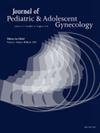13. Pain outcomes in adolescents with surgically confirmed endometriosis: A single-site retrospective cohort analysis
IF 1.8
4区 医学
Q3 OBSTETRICS & GYNECOLOGY
引用次数: 0
Abstract
Background
Endometriosis is a leading cause of dysmenorrhea globally, with two thirds of women reporting symptoms beginning in adolescence. Despite increased awareness of adolescent endometriosis, there is a paucity of data regarding best practice for surgical and medical management to improve pain outcomes. This study aims to analyze pain outcomes at one year post index surgery in adolescent patients with surgically diagnosed endometriosis.
Methods
This was a single-site, IRB-approved (STUDY2514), retrospective cohort study reviewing the care of natal females (12-22 years old) with surgically diagnosed endometriosis from 2009 to 2021. Baseline characteristics (demographics and preoperative clinical characteristics) were gathered from chart review. Surgery was classified as diagnostic laparoscopy only, versus ablation and/or excisional biopsy based on the surgeon's operative report. Subset analysis of post-op hormonal management with an intrauterine device (IUD) or leuprolide was performed. Changes in pain status (defined as resolved, improved, same, or worse) were gathered from the subjective documentation within gynecology appointment notes one year post-op. Statistical analysis was performed using independent t-tests and Chi-Squared/Fisher's Exact tests. Statistical significance was defined as p< 0.05.
Results
53 patients were identified in this study period. Mean age at time of index surgery was 15 (SD 1.7) years old, and the majority had stage 1 endometriosis. 66% of patients reported their pain was improved one year after their index surgery. There was no significant difference in pain outcome at one year based on whether a patient had a diagnostic surgery only compared to ablation and/or excisional biopsy of endometriosis lesions (p=0.43). There was no significant difference in pain based on the type of hormonal regimen implemented after the index surgery, including those who had an IUD (p=0.76) or received a post-operative course of leuprolide (p=0.7). There was no statistically significant difference in pain outcomes regarding patient demographics, including age (p=0.34) and BMI (p=0.36). Regarding pre-operative clinical characteristics, patients who reported worse pain had seen one additional specialist prior to diagnosis (p=0.005).
Conclusions
Over two thirds of patients who underwent surgical management of endometriosis reported their pain had improved one year following surgery. Patients who had worsening pain, had seen more specialists prior to their index surgery. There was no difference in pain outcomes based on the type of surgical or hormonal intervention, or other baseline patient characteristics.
13. 手术证实的子宫内膜异位症青少年的疼痛结局:单点回顾性队列分析
子宫内膜异位症是全球痛经的主要原因,三分之二的女性报告症状始于青春期。尽管对青少年子宫内膜异位症的认识有所提高,但缺乏关于改善疼痛结果的手术和医疗管理的最佳实践的数据。本研究旨在分析手术诊断为子宫内膜异位症的青少年患者术后一年的疼痛结果。方法:这是一项经irb批准的单点回顾性队列研究(study 2514),回顾了2009年至2021年手术诊断为子宫内膜异位症的出生女性(12-22岁)的护理。基线特征(人口统计学和术前临床特征)从图表回顾中收集。根据外科医生的手术报告,手术分为仅诊断性腹腔镜检查与消融和/或切除活检。对术后使用宫内节育器(IUD)或leuprolide进行激素管理的亚组分析。疼痛状态的变化(定义为缓解、改善、相同或更糟)从术后一年妇科预约记录中的主观记录中收集。采用独立t检验和Chi-Squared/Fisher’s Exact检验进行统计分析。统计学显著性定义为p<;0.05.结果本研究期间共发现53例患者。手术时的平均年龄为15岁(SD为1.7岁),多数为1期子宫内膜异位症。66%的患者报告他们的疼痛在手术后一年得到了改善。与子宫内膜异位症病变的消融和/或切除活检相比,患者是否仅进行诊断性手术,一年后疼痛结局无显著差异(p=0.43)。在指数手术后实施的激素治疗方案的类型上,包括那些使用宫内节育器(p=0.76)或接受术后leuprolide疗程(p=0.7)的患者,疼痛没有显著差异。两组患者的年龄(p=0.34)和BMI (p=0.36)等人口统计学差异无统计学意义。关于术前临床特征,报告疼痛加重的患者在诊断前曾见过另一位专科医生(p=0.005)。结论接受手术治疗的子宫内膜异位症患者中,超过三分之二的患者在手术一年后疼痛有所改善。疼痛加重的患者在手术前看过更多的专科医生。基于手术类型或激素干预或其他基线患者特征,疼痛结局没有差异。
本文章由计算机程序翻译,如有差异,请以英文原文为准。
求助全文
约1分钟内获得全文
求助全文
来源期刊
CiteScore
3.90
自引率
11.10%
发文量
251
审稿时长
57 days
期刊介绍:
Journal of Pediatric and Adolescent Gynecology includes all aspects of clinical and basic science research in pediatric and adolescent gynecology. The Journal draws on expertise from a variety of disciplines including pediatrics, obstetrics and gynecology, reproduction and gynecology, reproductive and pediatric endocrinology, genetics, and molecular biology.
The Journal of Pediatric and Adolescent Gynecology features original studies, review articles, book and literature reviews, letters to the editor, and communications in brief. It is an essential resource for the libraries of OB/GYN specialists, as well as pediatricians and primary care physicians.

 求助内容:
求助内容: 应助结果提醒方式:
应助结果提醒方式:


